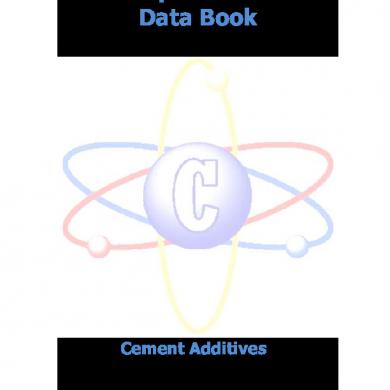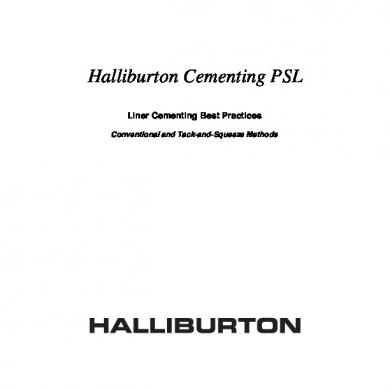Deepwater Cementing
This document was uploaded by user and they confirmed that they have the permission to share it. If you are author or own the copyright of this book, please report to us by using this DMCA report form. Report DMCA
Overview
Download & View Deepwater Cementing as PDF for free.
More details
- Words: 845
- Pages: 18
Loading documents preview...
Deepwater Cementing
What Makes Deepwater Different? Riserless drilling of top hole section Modeling and prediction of downhole temperatures Narrow margin between pore pressure and fracture gradients Beyond the conductor – Type of drilling fluids – Drilling fluid rheology – Tight clearances due to many casing – Casing damage due to trapped fluid pressure General differences – Cost of deepwater drilling rigs – More planning required 2 © 2011 HALLIBURTON. ALL RIGHTS RESERVED.
Deepwater Riserless Cementing Low seabed temperatures Narrow margin between pore pressure and fracture gradients Shallow Water Flow (SWF) potential Gas hydrates Poor displacement mechanics
What about ultra-deepwater? – Further cooling effects – Tighter fracture & pore pressure windows – Increased trip times can increase mud gels 3 © 2011 HALLIBURTON. ALL RIGHTS RESERVED.
Deepwater Riserless Solutions – BHCT & BHST Low temperature – – – –
API temps not suitable WellCat modelling for slurry placement temps Consider effects of Heat of Hydration (HoH) Optimise TT & CS to minimise WOC • Cement designs for low temps Undisturbed Model (BHST) MWD Measured Temperature Gradient Prediction (API) Model Prediction
4 © 2011 HALLIBURTON. ALL RIGHTS RESERVED.
Deepwater Riserless Solutions – BHCT & BHST Summary of Temperature Study – MWD / LWD BHCT’s frequently indicate BHCT well above the simulated BHCT throughout the well. – Predictions based on API tables are significantly higher than simulated BHCT throughout the well. • Over-predictions can affect the amount of retarder and/or other additives required for a slurry. • This can effect the set time of the cement based on the use of additional additives and retarders. • Incorrect temperature assumptions can ultimately increase non-productive time.
Deepwater Riserless Solutions – Slurry Design Tight fracture & pore pressure window – Low density slurries with low viscosity • Tuned Light / Foam Cement / EconoCem Shallow Water Flow – Cement with rapid transition time • GasStop / FlowStop Gas Hydrates – No documented cases of problems cementing across formations containing hydrates • If risk is considered high, use cement design with low Heat of Hydration
6 © 2011 HALLIBURTON. ALL RIGHTS RESERVED.
Deepwater Riserless Solutions – Mud Removal Poor Displacement Mechanics – Mud removal should be analysed with iCemSM Service – If poor mud removal is a risk consider ChannelSeal II • Settable Spotting Fluid (SSF) placed in the hole prior to running casing • Will set up faster when exposed to cement’s HoH
7 © 2011 HALLIBURTON. ALL RIGHTS RESERVED.
Managing The Interface Displacement Mechanics – Gel strength measurements – Aqueous and non-aqueous fluids • Compatibility and wettability – Erodibility models – Rheological hierarchy
Non-Gelling Drilling Fluid A
Severely Gelling Drilling Fluid B
Specific Lab Testing for Non-Aqueous Fluids Apparent Wettability Apparatus and methodology have been developed by Halliburton to provide the following: – a simple, repeatable test that can be carried out in any properly equipped cementing-service laboratory – the study of emulsion behavior of spacer and mud mixtures at any temperature up to 190°F – a method for customizing surfactant blends on an individual job basis for maximum performance and minimum material volumes – customization of phase inversion point for improved compatibility
SBM containing a Water Phase and an Oleaginous Phase Oil Phase
Water Phase Phase Inversion
Water Phase
Oil Phase
Emulsifiers Oil External Emulsion
Apparent Wettability Apparatus
Water External Emulsion
Annular Fluid Expansion Fluid Trapped in the annulus at low temperature will expand when exposed to the higher temperatures encountered while producing the well. This pressure increase can be large enough to cause severe casing damage Effective solutions: – Leave cement short of previous casing – Cement the entire annulus – Controlled leak path or bleed port – Compressible foamed fluids – Syntactic crushable foam wrap – Heavyweight casing design
Annular Pressure Buildup
Potential Pressure Increase on Trapped Annulus due to Temperature Increase 12000 Tap Water
10000
10.3 CaCl2 10.3 CaCl2 & Foamed Spacer
PSI
8000 6000 4000 2000 0 40
60
80
100
120
Temperature
140
160
180
Foam Quality Vs. Pressure
Conclusions / Summary #1 time saver in deepwater: – Do it right the first time! • Proper planning • Proper execution • Follow best practices and industry standards • Document lessons learned One squeeze job to remediate a poor primary cement job in deepwater can cost > $1,000,000
16 © 2011 HALLIBURTON. ALL RIGHTS RESERVED.
Case Histories / Best Practices “Deepwater Cementing Case History Using a HighStrength Lightweight Blend” – DOT Conference “Deepwater Cementing Best Practices for Riserless Section” – AADE-05-NTCE-70 “Deepwater Cementing Challenges” – SPE 56534 “Determination of Temperatures for Cementing in Wells Drilled in Deep Water” – IADC/SPE 39315 “Saving Expensive Offshore Deepwater Rig Time by Modeling Accurate Subsea/Subsea-Floor Temperature Modeling for Cementing Operations” – SPE 123738 “The Importance of Hydration Heat on Cement Strength Development for Deep Water Wells” – SPE 62894 “Improved Deepwater Cementing Practices Help Reduce Nonproductive Time” – IADC/SPE 99141 17 © 2011 HALLIBURTON. ALL RIGHTS RESERVED.
Questions
What Makes Deepwater Different? Riserless drilling of top hole section Modeling and prediction of downhole temperatures Narrow margin between pore pressure and fracture gradients Beyond the conductor – Type of drilling fluids – Drilling fluid rheology – Tight clearances due to many casing – Casing damage due to trapped fluid pressure General differences – Cost of deepwater drilling rigs – More planning required 2 © 2011 HALLIBURTON. ALL RIGHTS RESERVED.
Deepwater Riserless Cementing Low seabed temperatures Narrow margin between pore pressure and fracture gradients Shallow Water Flow (SWF) potential Gas hydrates Poor displacement mechanics
What about ultra-deepwater? – Further cooling effects – Tighter fracture & pore pressure windows – Increased trip times can increase mud gels 3 © 2011 HALLIBURTON. ALL RIGHTS RESERVED.
Deepwater Riserless Solutions – BHCT & BHST Low temperature – – – –
API temps not suitable WellCat modelling for slurry placement temps Consider effects of Heat of Hydration (HoH) Optimise TT & CS to minimise WOC • Cement designs for low temps Undisturbed Model (BHST) MWD Measured Temperature Gradient Prediction (API) Model Prediction
4 © 2011 HALLIBURTON. ALL RIGHTS RESERVED.
Deepwater Riserless Solutions – BHCT & BHST Summary of Temperature Study – MWD / LWD BHCT’s frequently indicate BHCT well above the simulated BHCT throughout the well. – Predictions based on API tables are significantly higher than simulated BHCT throughout the well. • Over-predictions can affect the amount of retarder and/or other additives required for a slurry. • This can effect the set time of the cement based on the use of additional additives and retarders. • Incorrect temperature assumptions can ultimately increase non-productive time.
Deepwater Riserless Solutions – Slurry Design Tight fracture & pore pressure window – Low density slurries with low viscosity • Tuned Light / Foam Cement / EconoCem Shallow Water Flow – Cement with rapid transition time • GasStop / FlowStop Gas Hydrates – No documented cases of problems cementing across formations containing hydrates • If risk is considered high, use cement design with low Heat of Hydration
6 © 2011 HALLIBURTON. ALL RIGHTS RESERVED.
Deepwater Riserless Solutions – Mud Removal Poor Displacement Mechanics – Mud removal should be analysed with iCemSM Service – If poor mud removal is a risk consider ChannelSeal II • Settable Spotting Fluid (SSF) placed in the hole prior to running casing • Will set up faster when exposed to cement’s HoH
7 © 2011 HALLIBURTON. ALL RIGHTS RESERVED.
Managing The Interface Displacement Mechanics – Gel strength measurements – Aqueous and non-aqueous fluids • Compatibility and wettability – Erodibility models – Rheological hierarchy
Non-Gelling Drilling Fluid A
Severely Gelling Drilling Fluid B
Specific Lab Testing for Non-Aqueous Fluids Apparent Wettability Apparatus and methodology have been developed by Halliburton to provide the following: – a simple, repeatable test that can be carried out in any properly equipped cementing-service laboratory – the study of emulsion behavior of spacer and mud mixtures at any temperature up to 190°F – a method for customizing surfactant blends on an individual job basis for maximum performance and minimum material volumes – customization of phase inversion point for improved compatibility
SBM containing a Water Phase and an Oleaginous Phase Oil Phase
Water Phase Phase Inversion
Water Phase
Oil Phase
Emulsifiers Oil External Emulsion
Apparent Wettability Apparatus
Water External Emulsion
Annular Fluid Expansion Fluid Trapped in the annulus at low temperature will expand when exposed to the higher temperatures encountered while producing the well. This pressure increase can be large enough to cause severe casing damage Effective solutions: – Leave cement short of previous casing – Cement the entire annulus – Controlled leak path or bleed port – Compressible foamed fluids – Syntactic crushable foam wrap – Heavyweight casing design
Annular Pressure Buildup
Potential Pressure Increase on Trapped Annulus due to Temperature Increase 12000 Tap Water
10000
10.3 CaCl2 10.3 CaCl2 & Foamed Spacer
PSI
8000 6000 4000 2000 0 40
60
80
100
120
Temperature
140
160
180
Foam Quality Vs. Pressure
Conclusions / Summary #1 time saver in deepwater: – Do it right the first time! • Proper planning • Proper execution • Follow best practices and industry standards • Document lessons learned One squeeze job to remediate a poor primary cement job in deepwater can cost > $1,000,000
16 © 2011 HALLIBURTON. ALL RIGHTS RESERVED.
Case Histories / Best Practices “Deepwater Cementing Case History Using a HighStrength Lightweight Blend” – DOT Conference “Deepwater Cementing Best Practices for Riserless Section” – AADE-05-NTCE-70 “Deepwater Cementing Challenges” – SPE 56534 “Determination of Temperatures for Cementing in Wells Drilled in Deep Water” – IADC/SPE 39315 “Saving Expensive Offshore Deepwater Rig Time by Modeling Accurate Subsea/Subsea-Floor Temperature Modeling for Cementing Operations” – SPE 123738 “The Importance of Hydration Heat on Cement Strength Development for Deep Water Wells” – SPE 62894 “Improved Deepwater Cementing Practices Help Reduce Nonproductive Time” – IADC/SPE 99141 17 © 2011 HALLIBURTON. ALL RIGHTS RESERVED.
Questions
Related Documents

Deepwater Cementing
January 2021 3
Deepwater Cementing Present
January 2021 1
Cementing
January 2021 1
Cementing
January 2021 4
Cementing Additives
January 2021 1
Halliburton Cementing Psl: Liner Cementing Best Practices
January 2021 1More Documents from "Tariq"

Deepwater Cementing
January 2021 3
Al Ash'ari, Kitab Al Luma
March 2021 0
Ex.3 Final Report
January 2021 1

